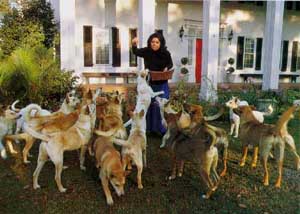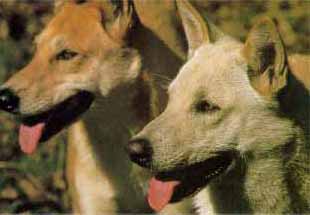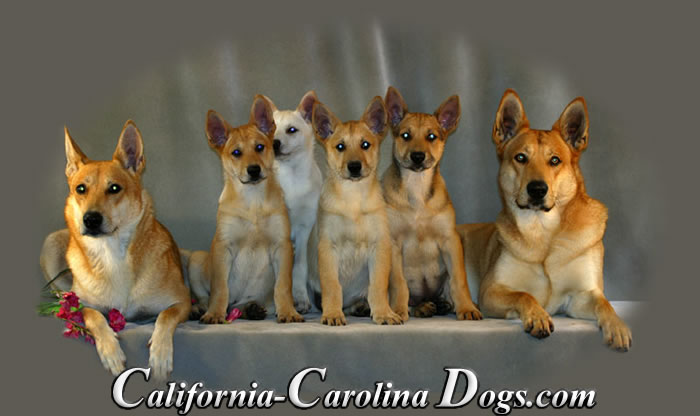“Tracking America's Native Breed”
Copyright 1999 Smithsonian Magazine
All photos by Lynda Richardson
ARTICLE PAGE 1 2 3 4 5
Sitting in a kennel, with only her head poking out of a box, was a dog that looked like she had stepped out of the Australian outback. The shelter operators thought Brisbin was crazy for taking the untamed animal, but they were also glad to find a home for such a thoroughly unadoptable dog. "So they go into the doghouse with a noose pole and drag her out screaming, spread-eagled, leaving claw marks through the kennel, and put her, urinating all over herself, into this cage in the back of my car. And I was handed 'a card, which I have to this day." Bris shakes his head and laughs. "It's got this little dog face, and it says, 'We are pleased you found room in your heart and your home to adopt this "Little One"'-who was yelping in my cage, shaking like a leaf-'who comes fully guaranteed to love, protect and be loyal to you as long as it lives." "And you know, ironically, she has", he says. Brisbin named the dog Marion, after Gen. Francis Marion, the "Swamp Fox" of the Revolutionary War. And while she has never become his "little one," she did learn to accept and tolerate him, the same way an aloof cat tolerates its owner, respectful but always distant, preserving her space and dignity.
 Today, Marion is a 14-year-old matriarch, her coat somewhat thread-bare, her muzzle gray and her eyes cloudy, her gait stiff and arthritic. But she retains some of the wildness that marked her early life; even around Brisbin she is shy and at a remove. A visitor who sits for a long time, pretending that he has no interest in her, may receive a careful sniff at his knee-but if he reaches to stroke her scarred muzzle she pulls back, not in alarm but maintaining distance.
Today, Marion is a 14-year-old matriarch, her coat somewhat thread-bare, her muzzle gray and her eyes cloudy, her gait stiff and arthritic. But she retains some of the wildness that marked her early life; even around Brisbin she is shy and at a remove. A visitor who sits for a long time, pretending that he has no interest in her, may receive a careful sniff at his knee-but if he reaches to stroke her scarred muzzle she pulls back, not in alarm but maintaining distance.
Brisbin acquired more of these feral pariahs, which he'd taken to calling Carolina dogs, from shelters and from the wild in South Carolina and Georgia. A number of them came from land surrounding large federal reservations, like Fort Gordon near Augusta, where much of the terrain remains undeveloped and undisturbed. Brisbin kept his Carolinas in a complex of kennels in an 18-acre enclosure where they could roam in the woodlots and fields. They started producing puppies--and surprises.
 Regardless of their origin, the Carolinas did things never before observed in domestic dogs. They had peculiar breeding cycles, starting with a rapid-fire, thrice-annual estrus in young females (perhaps a way to ensure quick breeding before diseases like heartworm took their toll) that later settled into seasonal reproductive cycles peaking in spring and late summer-the period, Brisbin notes, when small mammals are most abundant. Some pregnant females dug elaborate underground dens in which to give birth, unlike most domestic dogs, porch or into a handy pile of brush. When she was in estrus or after her puppies were born, a captive female would carefully cover her excrement by scraping sand over it with her nose.
Regardless of their origin, the Carolinas did things never before observed in domestic dogs. They had peculiar breeding cycles, starting with a rapid-fire, thrice-annual estrus in young females (perhaps a way to ensure quick breeding before diseases like heartworm took their toll) that later settled into seasonal reproductive cycles peaking in spring and late summer-the period, Brisbin notes, when small mammals are most abundant. Some pregnant females dug elaborate underground dens in which to give birth, unlike most domestic dogs, porch or into a handy pile of brush. When she was in estrus or after her puppies were born, a captive female would carefully cover her excrement by scraping sand over it with her nose.
To Brisbin's bafflement, the animals also dug what he calls "snout pits, "hundreds of small, conical depressions in the dirt that exactly fit the dogs' muzzles. Most snout pits are dug by females, between September and January. The dogs seem to be eating something, "but when I pull them out and look, there's never anything there," Brisbin says. They are particular about where they dig, and Brisbin can only conclude they're eating the soil itself, perhaps for its minerals.
With time, Bris became convinced he had stumbled onto something unique. The size, shape, color and behavior of the Carolina dogs, so similar to the the traits of other primitive canids, suggested they might be a relic of the first dogs to enter the region. He compared their skulls with those of Indian dogs from 2,ooo-year-old archaeological digs at Savannah River; they were similar, but there was too much individual variation among the fossils to be certain. But the fact that Carolina dogs are most often found in wild, swampy, sparsely settled regions, instead of more heavily populated areas where stray dogs are most common, is a strong indication to Brisbin that these are more than just mongrels.
Others agree; Bris has convinced both the American Rare Breeds Association and the United Kennel Club to recognize the Carolina dog. As with any registered breed, there is now a Carolina dog studbook to document and control breeding, and Brisbin's animals have even started winning "best in show" at multiple-breed dog shows. They are, of course, individuals. There are Lucy and Cici, both captured as wild pups, who vanish down their den holes before a stranger even steps from Brisbin's car. Dibble, the dominant female of the pack, is a bit standoffish, but Bo Pup, an adolescent, is all over me in seconds with openmouthed greetings. Surrey is a medium-sized female, daughter of Horace and Marion; Morgan is a solid, friendly chap whose drop ears belie his Carolina dog genes. If Marion is emblematic of a pariah dog's ancestral shyness, Taz is the polar opposite: a Carolina dog deeply, passionately, enthusiastically in love with people. He's Brisbin's home dog, a white-and-tan whose parents were both taken from the wild. Bris is bringing him up through the ranks of obedience training, aiming for the highest level. On the lead, Taz reacts instantly to hand and voice signals, but when the leash comes off as we walk in the woods, he vaults up steep banks with ease, and scrambles out on fallen tree trunks that span 20-foot-deep gullies.
NEXT PAGE